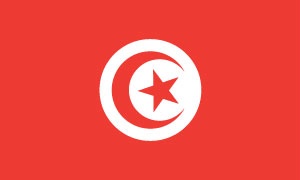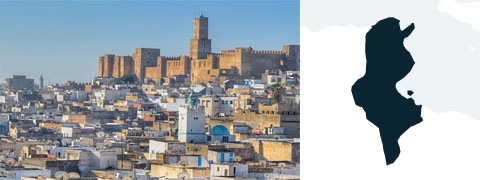Country assessments
Tunisia
- Details
- Country assessments
2013 sector transition indicators
Source: EBRD.
Note: Water – Water and wastewater; IAOFS – Insurance and other financial services; PE – Private equity.
Highlights
- Tunisia’s volatile political and security conditions, along with a weak external environment, have adversely affected the economy. The country’s deteriorating macroeconomic situation has prompted repeated downgrades of credit ratings. In response to rising macroeconomic challenges, the authorities obtained a US$ 1.74 billion loan from the International Monetary Fund (IMF) for a Stand-By Arrangement (SBA) in June 2013.
- The financial sector faces significant systemic risks. Deteriorating loan quality and profitability have increased existing banking sector vulnerabilities. Non-performing loans (NPLs) have risen, and the problem has been exacerbated by inadequate provisioning for bad loans.
- The government has embarked on a number of reform measures. Some positive steps have been taken with regard to subsidy reforms and improving the investment climate, but implementation of these measures continues to be delayed by political volatility.
Key priorities for 2014
- Addressing the fragility of the financial sector remains a top priority. Large state-owned banks are undercapitalised, and their balance sheets need to be restructured. The restructuring should be guided by the results of an independent audit of the three largest public banks.
- Investment is needed in the infrastructure and transport sectors. Private sector participation remains low, particularly at the municipal level, reflecting weaknesses in the regulatory framework and limited financing options beyond the central government.
- Reforms are needed in the energy sector to increase efficiency. The energy sector continues to operate with heavy state involvement and the prevalence of vertically integrated utility companies. More regulatory independence and tariff reform to reduce distortionary subsidies are needed.
Macroeconomic performance
Tunisia’s volatile political and security conditions, along with a weak external environment, have weighed on the economy. This has led to repeated downgrades of Tunisia’s sovereign credit rating by the three main credit rating agencies to below investment grade. The deteriorating macroeconomic situation and worsening external and fiscal debt positions, prompted the authorities to reach an agreement with the IMF over a US$ 1.74 billion Stand-By Arrangement in June 2013. The programme is expected to anchor economic reforms, helping to boost investor confidence and capital flows to the country, while bridging the country’s financing gap.
Real GDP growth rebounded in 2012, yet the economy faces substantial challenges. Output grew by 3.7 per cent in 2012, after contracting by 1.9 per cent in 2011. The recovery comes mainly on the back of a rebound in tourism and the mining sector, which were hit hard in 2011. The expansion in GDP was also driven by consumption, as a result of the increase in government spending. In the meantime, real GDP grew by 3.1 per cent in the second quarter of 2013, up from 2.6 per cent in the first quarter, regaining momentum following the assassination of an opposition leader in February 2013. However, it is likely that the latest political crisis, sparked by the killing of another opposition leader in July 2013, will hinder economic performance in the second half of 2013.
Tunisia’s current account and fiscal deficits have widened. The deteriorating trade balance, and weaknesses in tourism receipts, foreign direct investment and remittances, caused the current account deficit to widen to 8.1 per cent of GDP in 2012, up from 7.4 per cent in 2011. Foreign currency reserves have been kept just above three months of import cover, thanks to a Japanese-guaranteed bond issue, with reserves in September 2013 remaining stable at US$ 6.9 billion. Meanwhile, the fiscal deficit widened in 2012, reaching 5 per cent of GDP, owing to higher spending on social benefits, wages and subsidies. Nevertheless, the US$ 1.7 billion Stand-By Arrangement agreed with the IMF in June should help Tunisia meet its funding needs. In addition, Tunisia still has access to external financing: in August 2013, the government issued a 10-year Samurai bond of US$ 226 million, guaranteed by Japan, following a similar US$ 300 million bond in January.
Tunisia’s prospects for recovery remain vulnerable to political and policy uncertainties, as well as to developments in the eurozone. The political and security turmoil continue to dampen business activity and discourage investment. Additionally, the economy is highly exposed to spillovers from the slack in the eurozone, as Europe accounts for around 75 per cent of Tunisia’s total exports and around 85 per cent of total remittances and tourism receipts.
Major structural reform developments
Reform efforts have been stepped up. Continued political volatility has led to several delays in reforms. Nevertheless, Tunisia’s accession to advanced partnership status with the European Union in November 2012 should help to cement policy reform in the right direction. The most pressing issues are tackling corruption, reducing bureaucracy and strengthening the banking sector. The Tunisian government has already embarked on a number of reform measures, supported by an IMF SBA of US$ 1.74 billion, agreed in June 2013. The authorities have taken positive steps regarding energy subsidy reform, raising the prices of fuel and electricity in September 2012 and March 2013 in order to ease the fiscal burden and allow for greater cost recovery. Progress has also been made on improving the overall investment climate, through the preparation of a new investment code and a new draft Public-Private Partnership Law, as well as ongoing work on a new Competition Law. If these are implemented, they should foster a more favourable climate for private sector investment and participation. The proposed measures to decentralise decision-making could have positive impacts on municipal infrastructure investments.
The sale of assets confiscated from the previous regime has gathered pace. This has allowed the government to raise US$ 660 million, mostly through four large sales: a 15 per cent stake in the mobile phone firm, Tunisiana, was sold to Ooredoo (formerly Qatar Telecom); a 60 per cent stake in the vehicle distributor, Ennakl, was sold to a local consortium; a 67 per cent stake in City Cars was sold to a partnership between two local groups; and a 13 per cent stake in Banque de Tunisie was sold to France’s Banque Federative du Credit Mutuel. Assets confiscated from members of the former regime are estimated to be worth billions of dinars and are spread out over various sectors. Among the larger assets still to be sold are a 10 per cent stake in Tunisiana and a 31 per cent stake in City Cars (which are expected to be floated on the stock exchange), as well as a 51 per cent share in Orange Tunisie. However, the attractiveness of other Tunisian assets to foreign investors has been reduced by continuing economic turbulence, insecurity and uncertainty about the country’s political future, coupled with the fact that most of the firms up for sale are loss-making and carry significant debt.
The authorities have taken some steps to resolve debt problems in the tourism sector. The government is drafting a law to establish an asset management company to help restore the profitability of the tourism sector, by resolving its debts and disposing of NPLs in the banking sector, of which loans to the tourism sector account for 20 per cent. In exchange for government-guaranteed bonds, the asset management company will buy bad assets, improve the viability of exposed banks (including state-owned banks, which have the highest exposure) and allow for a higher recovery rate of bad loans.
Progress has been made on reforms to the telecommunications sector. Amendments to the Communications Law were approved in early 2013, increasing the powers of the sector regulator, the Instance Nationale des Telecommunications. A regulatory framework was also introduced, and access to existing telecommunications networks held by the public utilities was liberalised. While this will help to improve services and access in the telecommunications sector, further reforms could improve competitiveness and encourage investment.
A decentralisation policy has been announced concerning regional infrastructure. Public spending has been earmarked for infrastructure investments in marginalised regions, with a focus on attracting private sector participation. The increase in public investment is to be accompanied by the decentralisation of the administration and the setting of objective criteria for selecting investment projects. Nevertheless, further unbundling, tariff reform and regulatory independence remain key reform challenges, especially in the transport and municipal sectors.
The authorities have announced plans to reform the banking sector. The government has announced an independent audit of the three public banks (accounting for around 40 per cent of total banking assets), which is to be completed in December 2013. The results will determine the government’s restructuring strategy for those banks. Other reforms are being devised to reduce the vulnerability of the banking system, including strengthening bank supervision and streamlining prudential norms. In July 2013 Tunisia’s parliament approved a law allowing for the issue of sukuk, or Islamic bonds, which could be an important alternative source of financing. The government has announced plans to launch a US$ 700 million sovereign sukuk by the end of the year. Lastly, ceilings on creditor interest rates were eliminated in March 2013, which will facilitate the development of the interbank market.













